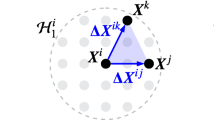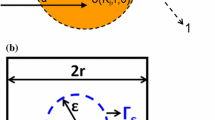Abstract
Peridynamic models are derived by assuming that a material point is located in the bulk. Near a surface or boundary, material points do not have a full non-local neighborhood. This leads to effective material properties near the surface of a peridynamic model to be slightly different from those in the bulk. A number of methods/algorithms have been proposed recently for correcting this peridynamic surface effect. In this study, we investigate the efficacy and computational cost of peridynamic surface correction methods for elasticity and fracture. We provide practical suggestions for reducing the peridynamic surface effect.




















Similar content being viewed by others
References
Silling SA (2000) Reformulation of elasticity theory for discontinuities and long-range forces. J Mech Phys Solids 48:175–209
Silling SA, Askari E (2005) A meshfree method based on the peridynamic model of solid mechanics. Comput. Struct. 83:1526–1535
Silling SA, Epton M, Weckner O, Xu J, Askari E (2007) Peridynamic states and constitutive modeling. J Elast 88:151–184
Silling SA, Lehoucq RB (2008) Convergence of peridynamics to classical elasticity theory. J Elast 93:13–37
Emmrich E, Weckner O (2007) On the well-posedness of the linear peridynamic model and its convergence towards the Navier equation of linear elasticity. Commun Math Sci 5:851–864
Han W, Liu WK (2005) Flexible piecewise approximations based on partition of unity. Adv Comput Math 23:191–199
Kim DW, Liu WK (2006) Maximum principle and convergence analysis for the meshfree point collocation method. SIAM J Numer Anal 44:515–539
Liu WK, Han W, Lu H, Li S, Cao J (2004) Reproducing kernel element method. Part I: theoretical formulation. Comput Methods Appl Mech Eng 193:933–951
Li S, Lu H, Han W, Liu WK, Simkins DC (2004) Reproducing kernel element method Part II: globally conforming \(I^m/C^n\) hierarchies. Comput Methods Appl Mech Eng 193:953–987
Lu H, Li S, Simkins DC, Liu WK, Cao J (2004) Reproducing kernel element method Part III: generalized enrichment and applications. Comput Methods Appl Mech Eng 193:989–1011
Simkins DC, Li S, Lu H, Liu WK (2004) Reproducing kernel element method. Part IV: globally compatible \(\text{ C }^{{\rm n}} ({\rm n}\geqslant 1)\) triangular hierarchy. Comput Methods Appl Mech Eng 193:1013–1034
Gerstle W H, Sau N, Silling S A (2005) Peridynamic modeling of plain and reinforced concrete structures. In: Presented at the 18th international conference on structural mechanics in reactor technology, Beijing, China
Bobaru F, Ha YD (2011) Adaptive refinement and multiscale modeling in 2D peridynamics. J Multisc Comput Eng 9:635–660
Chen Z, Bakenhus D, Bobaru F (2016) A constructive peridynamic kernel for elasticity. Comput Methods Appl Mech Eng 311:356–373
Chen Z, Bobaru F (2015) Selecting the kernel in a peridynamic formulation: a study for transient heat diffusion. Comput Phys Commun 197:51–60
Du Q, Tian L, Zhao X (2013) A convergent adaptive finite element algorithm for nonlocal diffusion and peridynamic models. SIAM J Num Anal 51:1211–1234
Tian XC, Du Q (2013) Analysis and comparison of different approximations to nonlocal diffusion and linear peridynamic equations. SIAM J Num Anal 51:3458–3482
Macek RW, Silling SA (2007) Peridynamics via finite element analysis. Fin Elem Anal Design 43:1169–1178
Gunzburger M, Lehoucq RB (2010) A nonlocal vector calculus with application to nonlocal boundary value problems. Multisc Model Simul 8:1581–1598
Silling SA, Lehoucq RB (2010) Peridynamic theory of solid mechanics. Adv Appl Mech 44:73–168
Bobaru F, Foster JT, Geubelle PH, Silling SA (2017) Handbook of peridynamic modeling. CRC Press, Taylor & Francis Group, Boca Raton
Le QV, Chan WK, Schwartz J (2014) A two-dimensional ordinary, state-based peridynamic model for linearly elastic solids. Int J Numer Methods Eng 98:547–561
Sarego G, Le QV, Bobaru F, Zaccariotto M, Galvanetto U (2016) Linearized state-based peridynamics for 2D problems. Int J Numer Methods Eng 108:1174–1197
Madenci E, Oterkus E (2014) Coupling of the peridynamic theory and finite element method. In: Peridynamic theory and its applications, Springer, ed New York, pp 191–202
Oterkus E (2010) Peridynamic theory for modeling three-dimensional damage growth in metallic and composite structures, Ph.D. thesis, The University of Arizona
Mitchell JA, Silling SA, Littlewood DJ (2015) A position-aware linear solid constitutive model for peridynamics. J Mech Mater Struct 10:539–557
Emmrich E, Weckner O (2007) The peridynamic equation and its spatial discretisation. Math Model Anal 12:17–27
Seleson P, Parks ML, Gunzburger M, Lehoucq RB (2009) Peridynamics as an upscaling of molecular dynamics. Multisc Model Simul 8:204–227
Chen Z, Bobaru F (2015) Peridynamic modeling of pitting corrosion damage. J Mech Phys Solids 78:352–381
Seleson P (2014) Improved one-point quadrature algorithms for two-dimensional peridynamic models based on analytical calculations. Comput Methods Appl Mech Eng 282:184–217
Henke SF, Shanbhag S (2014) Mesh sensitivity in peridynamic simulations. Comput Phys Commun 185:181–193
Hu W, Ha Y D, Bobaru F (2010) Numerical integration in peridynamics. In: Technical report, University of Nebraska-Lincoln
Du Q, Gunzburger M, Lehoucq RB, Zhou K (2013) A nonlocal vector calculus, nonlocal volume-constrained problems, and nonlocal balance laws. Math Models Methods Appl Sci 23:493–540
Tao Y, Tian X, Du Q (2017) Nonlocal diffusion and peridynamic models with Neumann type constraints and their numerical approximations. Appl Math Comput 305:282–298
Shewchuk JR (1994) An introduction to the conjugate gradient method without the agonizing pain. In: Technical report school of computer science. Carnegie Mellon University
Silling SA (2010) Linearized theory of peridynamic states. J Elast 99:85–111
Kilic B, Madenci E (2010) Peridynamic theory for thermomechanical analysis. IEEE Trans Adv Packag 33:97–105
Kilic B, Agwai A, Madenci E (2009) Peridynamic theory for progressive damage prediction in center-cracked composite laminates. Compos Struct 90:141–151
Bobaru F, Yang M, Alves LF, Silling SA, Askari E, Xu J (2009) Convergence, adaptive refinement, and scaling in 1D peridynamics. Int J Numer Methods Eng 77:852–877
Dipasquale D, Sarego G, Zaccariotto M, Galvanetto U (2016) Dependence of crack paths on the orientation of regular 2D peridynamic grids. Eng Fract Mech 160:248–263
Hu W, Ha YD, Bobaru F (2011) Modeling dynamic fracture and damage in a fiber-reinforced composite lamina with peridynamics. Intl J Multisc Comput Eng 9:707–726
Gerstle WH (2016) Introduction to Practical Peridynamics. World Scientific Publishing Co., Singapore
Ha Y, Bobaru F (2010) Studies of dynamic crack propagation and crack branching with peridynamics. Int J Fract 162:229–244
Madenci E, Oterkus E (2014) Peridynamic theory and its applications. Springer, Berlin
Timoshenko S, Goodier JN (1969) Theory of elasticity. McGraw-Hill, New York City
Oterkus S, Madenci E, Agwai A (2014) Peridynamic thermal diffusion. J Comput Phys 265:71–96
Oterkus S (2015) Peridynamics for the solution of multiphysics problems. Ph.D. thesis, The University of Arizona
Rice JR (1968) A path independent integral and the approximate analysis of strain concentration by notches and cracks. J Appl Mech 35:379–386
Hu W, Ha Y, Bobaru F, Silling S (2012) The formulation and computation of the nonlocal J-integral in bond-based peridynamics. Int J Fract 176:195–206
Silling SA (2014) Origin and effect of nonlocality in a composite. J Mech Mater Struct 9:245–258
Dipasquale D, Zaccariotto M, Galvanetto U (2014) Crack propagation with adaptive grid refinement in 2D peridynamics. Int J Fract 190:1–22
Acknowledgements
This work has been supported by AFOSR MURI Center for Materials Failure Prediction through Peridynamics (program managers Drs. Jaimie Tiley, David Stargel, Ali Sayir, and Fariba Fahroo) and ONR grant (program manager William Nickerson).
Author information
Authors and Affiliations
Corresponding author
Rights and permissions
About this article
Cite this article
Le, Q.V., Bobaru, F. Surface corrections for peridynamic models in elasticity and fracture. Comput Mech 61, 499–518 (2018). https://doi.org/10.1007/s00466-017-1469-1
Received:
Accepted:
Published:
Issue Date:
DOI: https://doi.org/10.1007/s00466-017-1469-1




